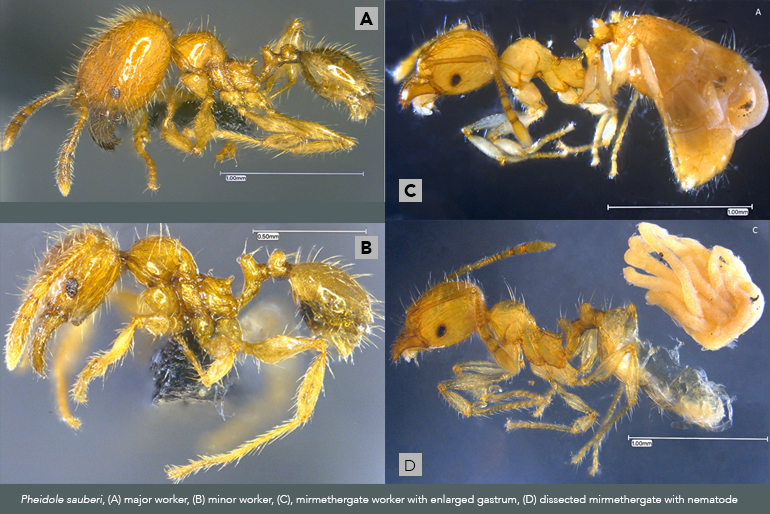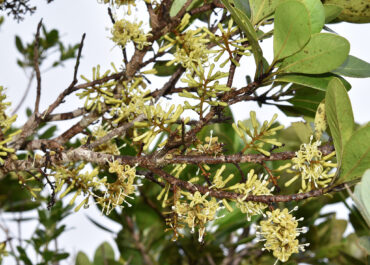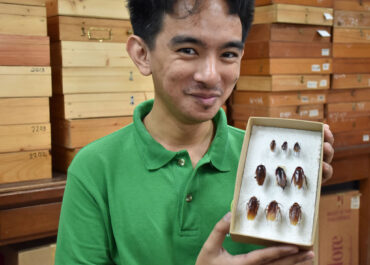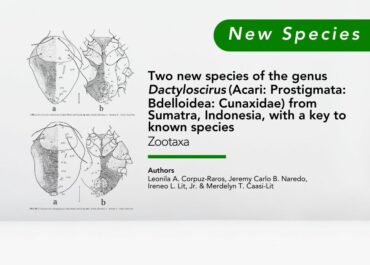Museum entomologists records first case of nematode parasitism in Philippine ants

Former UPLB MNH curator for ants Dr. David Emmanuel M. General and his entomologist co-worker, Perry Archival C. Buenavente of the National Museum of the Philippines recently reported the first case of mermithism in ants in the Philippines. Mermithism is a condition in ants wherein an endoparasite nematode infects it, causing morphological changes to the ant.
In their paper recently published by the Philippine Journal of Systematic Biology (http://asbp.org.ph/wp-content/uploads/2021/12/PJSB_2021-001.pdf), General and Buenavente wrote that they discovered the occurrence of mermithism in Pheidole sauberi, an ant species native to the Philippines, which they collected from the town of Governor Generoso in Davao Oriental Province.
“In January 2021 transect survey in the area, we were able to find a series of P. sauberi nests in rotten wood laying on the ground,” Dr. General relayed during an interview. Some of the P. sauberi individuals they were able to collect, according to Dr. General, had unique features which warranted more in depth study. “A colony of P. sauberi contains a single queen and around 600 workers. We were able to classify the workers we collected into three size classes: major workers, minor workers, and, interestingly, we found pale workers of intermediate size but with rather large gasters (abdomen),” General said.
Prior to this present discovery, Dr. General previously wrote in an article published in 2021 that in the course of his studies, he found an unrecognized wingless ant queen which was confusingly similar to ants that have been disfigured by nematodes. “That observation gave us the impetus to try and collect whole nests of ants since ant colonies can harbor a diverse array of parasites and pathogens,” General later explained.
Very recent studies have documented that parasites and pathogens can cause physical changes in ants which can be passed on to the next generation. Oftentimes, these changes cause striking morphology which taxonomists may confuse as unique, hence, consider the ant species as undescribed or new.
“In our collections, we were fortunate enough to find several mermithergates or workers which have changed appearance due to nematode infection,” General said.
According to their findings, these mermithergates were in between the major and minor worker in terms of body size. However, the gaster is disproportionately larger, and in addition, distinctly paler in color than either worker.
“When we opened the protruding abdomen of a worker, we were able to find a relatively large nematode inside; which is now preserved for further study by a parasitologist at the UPLB Institute of Biological Sciences,” he said.
“Not only that, we were also able to describe the wingless queen of P. sauberi, which had remained undescribed since the species was discovered by Swiss myrmecologist Auguste-Henri Forel in 1905,” he added.
General and Buenavente’s study has been able to establish the first case of mermithism in ants in the Philippines and thereby gives a solid argument for the need for Filipino taxonomists to collect nests which is also a treasure trove of information on ants.
“Mermithism in ants, particularly in the Philippines, is largely unknown. There may be other ant species which may be infected by other nematode species,” General said.
Search
Archives
Categories
- Announcement (21)
- Feature (21)
- News (141)
- Press Release (55)
- Research (4)
- Services (3)



